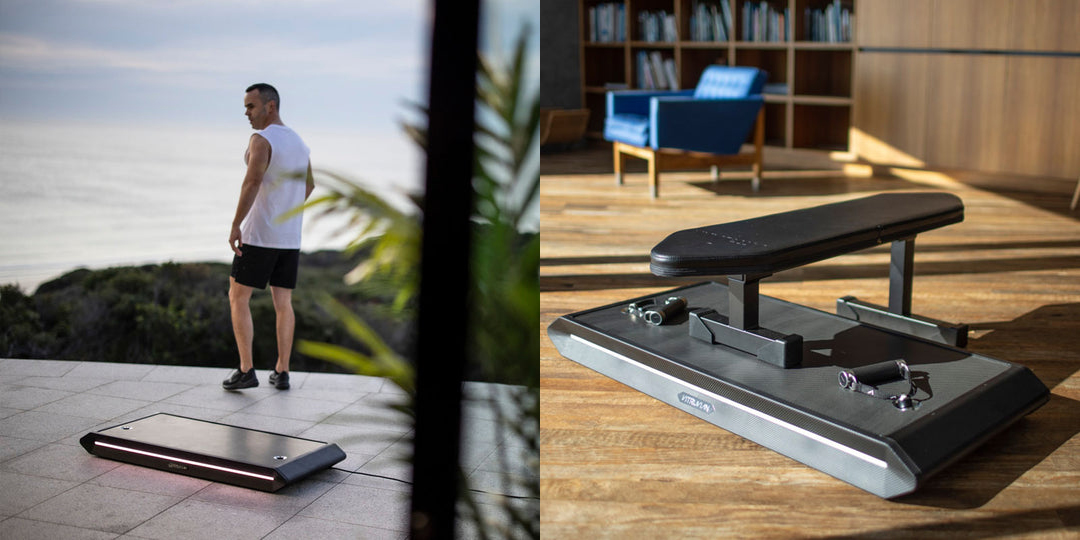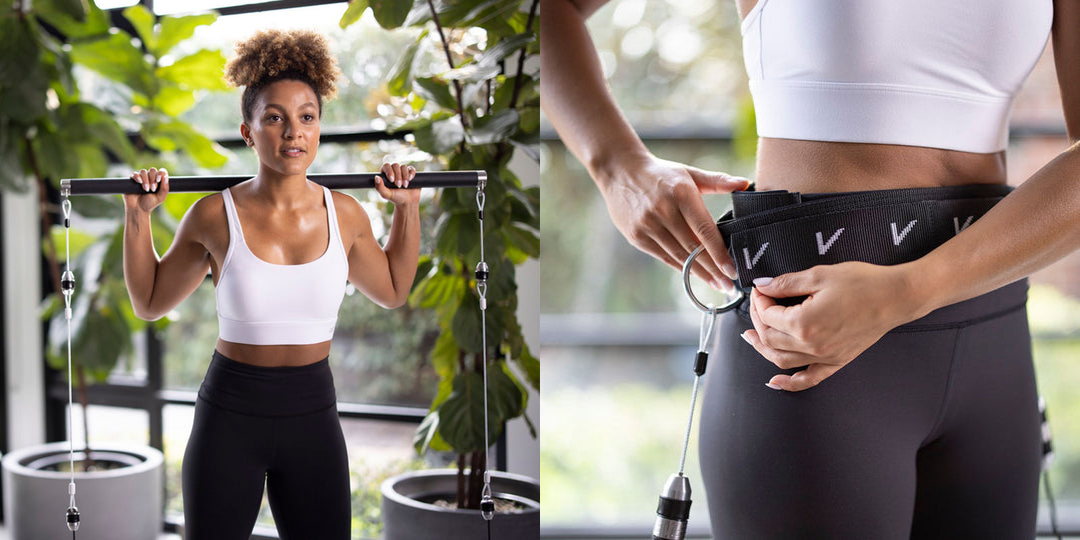The connected home gym gear craze probably experienced its zenith during the height of the COVID-19 pandemic, with indicators like Peloton’s fortunes pointing to waning interest as people get back to using their gym memberships. But the category still has plenty of potential, especially if the gear in question can combine smarts with other key value propositions, including a small footprint that can fit into anyone’s home. Vitruvian’s Trainer+ offers that and more, nailing the tricky proposition of offering a comprehensive weight training experience at home while keeping things small and simple.
The basics
The Vitruvian Trainer+ is not cheap. At $2,990, it’s around the cost of six years of gym membership at the average rate paid in the U.S. per month, and that doesn’t include the Vitruvian All Access recurring subscription fee for access to advanced workout features including guided sessions, which is a hefty $39 per month after the first 12 months, which are included free with the purchase of the machine.
That the recurring sub is itself more expensive than the average American pays for their monthly gym membership is a very steep hill to climb, and clearly Vitruvian knows it since they don’t make it very easy to find that pricing on their website — even in the FAQ question that specifically asks how much the membership costs. You can opt to pay for a subscription that lasts the lifetime of your machine for a one-time fee of $990, which is definitely a better deal if you actually are using the machine consistently and plan to continue. Finally, you can always opt not to use the subscription features, which still gives you a very capable piece of workout hardware as long as you’re good at charting your own workout path.
Speaking of the hardware, it’s actually easy to see why even with a base price of nearly $3K, Vitruvian needs to also ask a hefty recurring fee from its users: The Trainer+ is a fantastic piece of kit that no doubt incurred high development and production costs.
What you get is a compact but solid platform with two clips that connect external accessories including various handles, a barbell and ropes to an active resistance mechanism contained within. The platform itself is easy to tuck under a couch or table, and measures just around 46 by 20 inches and weighs only 80 lbs. Considering the range of workouts the Trainer+ offers, and the fact that it can provide anywhere up to 440 lbs of resistance, the fact that it comes in such a relatively small package is incredibly impressive.
The Trainer+ is super easy to set up and pair with your smartphone using a QR code on the machine itself, and the quick clipping system it uses to connect to handles and other accessories is incredibly smart and useful for rapidly switching between different items during a structured workout.
Resistance is controlled by the app, and every time you start a workout the machine requires three setup reps to establish your proper range of motion before you get into doing the exercises with actual weight. Once you do get into an actual exercise, there are three possible modes for each, including one that adds 1 kg (2.2 lbs) with each clean rep, once that decreases weight over time, and a sustained mode where weight stays the same.
Design
On the surface, there’s not much too the Trainer+’s design: The flashiest thing about it is the customizable LED lighting that also offers some helpful visual cues about whether you’re competing reps properly or not. Otherwise, it looks like an overgrown Wii Balance board if you’re old enough to remember what that is, or basically just an elevated stand. The Trainer+’s top surface is made from a carbon-fibre composite, which is fine to use on its own with training shoes, but you can also opt to get the additional soft, tacky mat that is included in either the Entry or Pro level accessory kit (I received the $500 Pro kit in my sample package).
As mentioned, the Trainer+ is around 80 lbs, and it comes in one solid pre-assembled piece. Setup is therefore a breeze compared to just about any other home gym equipment, but you probably should get another person to help you moving it, say, up and down stairs. For moving it around your space, there are wheels on the underside that come in contact with the ground when you tip one end up, making it easy to slide across floors for storing under a couch or desk.
The key to Trainer+’s versatility are its two recessed “Quick Connection System” receptors, which are themselves permanently connected to retractable cables that tie into the device’s programmable active resistance system. The quick connectors allow the included handles and ankle straps to easily snap in, and they release via a simple collar push mechanism that won’t come loose in use but that is dead simple to change out between exercises. This replaces a much more cumbersome carabiner system on the Trainer+’s predecessor, and it’s a fantastic, intuitive upgrade.
Another area where Trainer+’s overall cost of ownership creeps higher still is with the various attachments on offer. There’s a ‘Basic’ kit that adds a long bar, a tricep rope, “premium” handles, the aforementioned workout mat and safety cables. Then the ‘Pro’ kit that I tested the Trainer+ with includes all that, along with a short bar, a belt, and even a bench. You can accomplish a lot with the Trainer+ without any of these things, but the truth is that the experience is greatly enhanced by adding them in – especially the bench and bar – and you can’t buy them piecemeal.
The Trainer+ works with a dedicated Vitruvian companion app, which connects to your machine via Bluetooth. The good thing about the expensive All-Access membership is that it’s tied to the machine, not the individual – meaning anyone in your household (or even visitors) can create their own profile in the app on their own phone and pair with your machine to access all training options and guided workouts. The app itself is great, offering multi-week programs you can follow, trainer-led classes, and a wide range of individual exercises that you can assemble into your own custom workouts if you’re a subscriber, too. I used the app’s guided video on my gym Apple TV via AirPlay and that worked flawlessly as well.
Performance
The Trainer+ is probably going to feel different from other workouts you’ve tried if you haven’t used an active resistance machine in the past: it’s different from either all-in-one cable and weight-based equipment, or free weights. To Vitruvian’s credit, though, the learning curve is not at all steep, and it only takes a couple of sessions before using the Trainer+ feels like second nature.
Vitruvian’s app provides everything you need to use the Trainer+ to max effectiveness, too, whether you’re just starting out, or you’re experienced with personal fitness and looking fro something to fit into or supplement your existing routine. It’s basically as guided or as self-directed as you want, and anywhere in between.
The Trainer+ is also great at making real-time adjustments to your workout based on your strength and performance level. There’s a strength assessment that the app will ask you to do initially to establish your baseline suggested weights for all the various workouts, and you can jump back into that at any point to change that calibration, which is useful to do every few weeks as you progress with your training.
In a month of testing, with near daily use, the Trainer+ had been incredibly consistent. Once you’re done with a workout, you can just let the handles or attachments drop and the cables retract, without having to worry about damaging the durable carbon composite material of the hardware itself. The clips come in and out easily, and the platform is easy to wipe down with simple soap and water when needed. The connection is rock solid and remembers your phone so long as you toggle that option in the app, and the Trainer+ automatically sleeps so you can leave it plugged in all the time if you want.
One issue I found with the machine: The power cable seems to sit rather lightly in the socket on the machine, and until I learned how to steer well clear of it, it was relatively easy to cut power to the Trainer+ just by even lightly brushing the cord itself. That hasn’t been an issue since identifying it as a problem and avoiding any contact with the cord, and it’s possible this was included intentionally as a kind of safety backup, but I’d appreciate a more snug fit between cable and machine.
Bottom line
There’s no question that the Trainer+ is a fantastic piece of home workout hardware, with a smart, useful app that’s at once far more approachable than something like Peloton, but also much more flexible for people who take working out very seriously and want to be able to customize their experience to match.
The real sticking point with Vitruvian’s offering, however, is the price: With the Pro kit, which I do recommend, you’re already at $3,500, and that’s before you start adding in the ongoing cost of the app subscription. That could pay for a fair amount of gym membership, along with some personal training thrown in.
With the Trainer+, however, you get a number of things that are basically impossible to get anywhere else, including a solution that’s so portable it not only works in just about any home or condo setting, but can also easily pack into the car for a road trip – or fit into your #vanlife if that’s what you’re into. It’s much more versatile in this regard vs. other similar active resistance products like the Tonal, too.
If you place a premium on flexibility with almost zero sacrifices vs. a full set of free weights or a much more cumbersome home tower or complete gym, then the Trainer+ is easy to recommend. It’s clearly well-engineered and designed, with a focus on delivering value to actual athletes and fitness buffs who can be notoriously hard to please, and yet it’s also a great place for people to start out their home exercise journeys – so long as they want to commit the the upfront cost that comes with it.
Where to buy: Vitruvian’s website
Vitruvian’s Trainer+ is an all-in-one home gym that actually lives up to its promises by Darrell Etherington originally published on TechCrunch
DUOS







